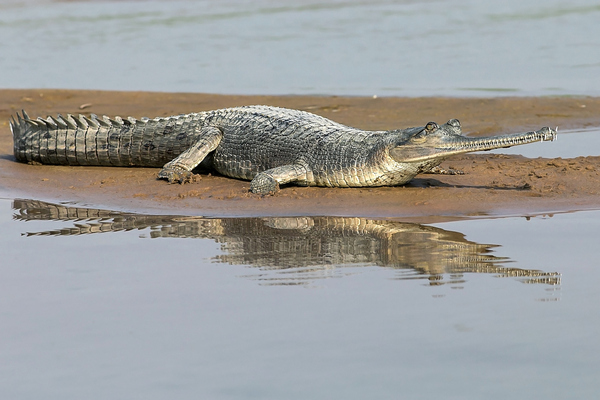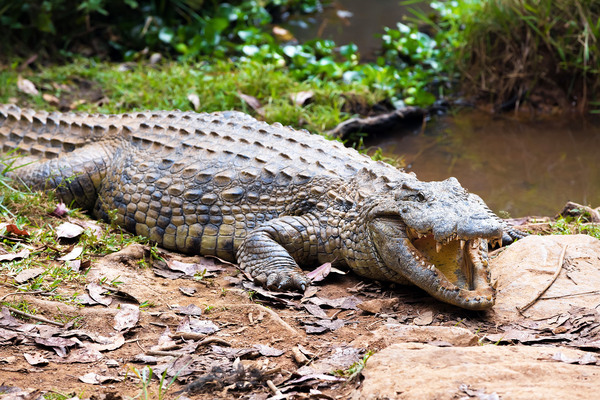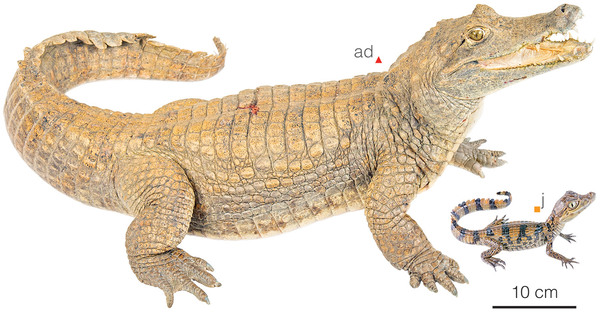As an ancient amphibian and reptile on earth that is contemporary with dinosaurs, crocodiles are known as one of the "living fossils". Their origins can be traced back to more than 200 million years ago, and they have always maintained superior survivability. Do you know anything about the crocodile species in the world? This article will introduce the top ten well-known crocodile species in the world, including estuarine crocodile, gharial crocodile, Nile crocodile, Siamese crocodile, Malayan crocodile, Peten crocodile, Philippine crocodile, American alligator, caiman and alligator. Let's explore the world of these ancient creatures.

1. Gharial

The gharial is a member of the family Alligatoridae, belonging to the genus Alligator, and is one of the largest crocodiles in the world. The body length of male gharials is generally between 5 and 6 meters, and the weight is between 159 and 250 kilograms; while the body length of females is about 3.5 to 4.5 meters, and the weight is between 100 and 130 kilograms. Gharials mainly inhabit rivers, ponds, swamps and artificial waters in India, Sri Lanka, Pakistan and Nepal. In addition to feeding on fish, they can also prey on large mammals, including humans. However, gharials do not actively attack people.
2. Estuarine crocodile

Estuarine crocodile, also known as Saltwater crocodile, Gulf crocodile, is one of the 23 known species of crocodile and is also One of the largest living reptiles on earth. Adult estuarine crocodiles can reach 5 to 7 meters in length and weigh between 500 and 1,400 kilograms. This type of crocodile is ferocious, strong, good at swimming, and widely distributed, mainly in Southeast Asia, South Asia, the Philippines, Papua New Guinea, the Malay Islands, and northern Australia. Estuarine crocodiles eat a wide range of foods, including fish, amphibians, reptiles and large mammals. Sometimes they even attack and prey on humans.
3. Nile crocodile

Nile crocodile, also known as African crocodile, is the largest reptile in Africa, up to 6 meters long and weighing 1 ton. It has attracted the attention of human research among various types of crocodiles around the world. Nile crocodiles mainly inhabit the Nile River Basin and southeastern areas of Africa, and also appear on the island of Madagascar. Their food sources range from antelope, zebra, buffalo to even young hippopotamus and Elephants-Are-Endangered.html">elephants, as well as fish and birds, and sometimes even attack humans. Nile crocodiles are often hunted by humans because of their huge size to make leather and other products. They are not available in China.
4. Siamese crocodile

The Siamese crocodile is a species of medium-sized crocodile. The length of adult individuals can reach up to 4 meters. Under normal circumstances, there are individuals with a length of 3 meters. The length of juvenile crocodiles is about 25 centimeters when they hatch. Siamese crocodile is well-known for its leather in the international market, and the value of its hide is directly proportional to the size of the hide. Wild Siamese crocodiles are mainly distributed in Borneo, Indonesia, Malaysia, Thailand and Vietnam in Southeast Asia.
Siamese crocodiles play a role at the top of the food chain in wetland ecosystems. Juvenile individuals mainly feed on insects, amphibians, crustaceans, young reptiles and fish, while adults will prey on larger animals, although fish Their main diet is amphibians, reptiles, and small mammals.
5. Malayan crocodile

The Malayan crocodile, also known as the Malayan crocodile, was widely distributed in the early days and was even recorded in southern China hundreds of years ago. Currently, this crocodile mainly inhabits freshwater swamps, lakes and rivers in places such as the Malay Peninsula, Kalimantan, Sumatra and Java. The average body length of the Malayan crocodile is about 3 meters, and there are also larger individuals reaching 4 meters. Although the Malayan crocodile is very similar in appearance to the gharial, its head gradually shrinks toward the snout, and male Malayan crocodiles do not have the characteristic bulbous protrusion at the snout of the gharial.
6. Petensuchus

Peten's crocodile, commonly known as Central American crocodile, Mexican crocodile or Belize crocodile, is a medium-sized crocodile with a wide snout, with a body length of approximately 3 to 3.4 meters. It is a smaller species, generally about 3 meters in length. The Petensuchus has a broader snout and is similar in appearance to the American crocodile, but is generally darker in color, with dark gray-brown stripes and spots on its body and tail.
This crocodile usually inhabits freshwater ponds, rivers, and swamps from southern Mexico to northern Guatemala, and is sometimes found near the Atlantic coastline.
7. Philippine crocodile

The Mandoro crocodile, also known as the Philippine crocodile, is a special species of crocodile distributed exclusively in the Philippine Islands. The length is approximately 2.4 to 2.7 meters, and the weight is between 15 and 36 kilograms. Compared with other crocodiles, the snout of the Philippine crocodile is wider and the body is relatively small, usually no more than 3 meters. The males are generally larger than the females.

Although this crocodile is not overly aggressive, it will bite when disturbed. The Philippine crocodile is listed as an endangered species. According to the 2008 selection by the American website "Live Science", the Philippine crocodile is ranked among the top ten endangered rare animal species in the world.
8. American alligator

The American alligator, also known as the alligator, is a larger crocodile species in the Western Hemisphere, usually between 1.8 meters and 2.7 meters long. However, according to the Everglades National Park website, the largest alligator ever recorded in Florida was 5.3 meters long, while the largest American alligator was found in Everglades Island near Lake Washington and in Louisiana, measuring 5.8 meters long. rice. This demonstrates the potential growth potential of the American alligator. American alligators are mainly found in large rivers and inland lakes in the United States and are endemic to the United States.
9. Caiman

Caiman refers to an animal in the genus Caiman of the family Alligatoridae. It is a type of small to medium-sized crocodile. Compared with crocodiles of the genus Eusuchus of the same size, caiman's bite force is weaker because their mouth opening muscles are not as developed as other crocodiles, so an adult man can easily prevent it from opening its mouth. This shortcoming has also become a weapon for crocodile hunters to capture caiman. The body length of ordinary caiman can reach up to 2.5 meters, and the body length of adult caiman is usually between 1.5 and 2 meters. They are mainly distributed in rivers in Central and South America.
10. Alligator

The alligator, commonly known as tuó, is a crocodile in the family Alligatoridae and is listed as a national first-level protected animal in my country. As a species endemic to China, the alligator is also one of the smallest crocodiles in the world. Its existing population is rare and on the verge of extinction, making it one of the endangered reptiles in the world. With many unique characteristics of dinosaur-like reptiles, the alligator is known as a "living fossil." Therefore, studying the alligator is of great significance for exploring the rise and fall of ancient reptiles, paleogeology, and the evolution of organisms.

animal tags:
We created this article in conjunction with AI technology, then made sure it was fact-checked and edited by a Animals Top editor.